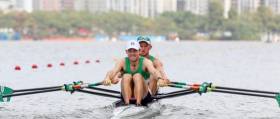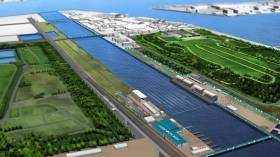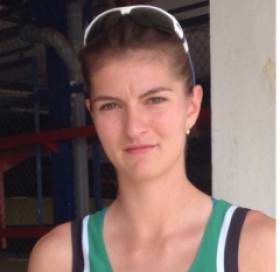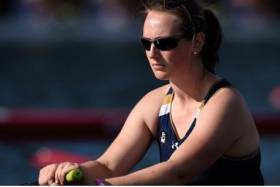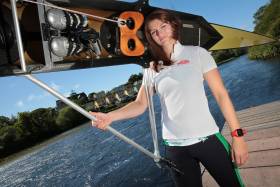Displaying items by tag: rowing
O’Donovan Brothers Are RTÉ’s Sport Team Of 2016
#Rowing - Paul and Gary O’Donovan were last night named Team of the Year at the RTÉ Sport Awards, as RTÉ News reports.
The Olympic silver medallists in the lightweight double sculls in Rio this summer captured the hearts of the nation with their light-hearted post-race interview and subsequent appearance on The Late Late Show with fellow Olympic hero Annalise Murphy.
And just like Murphy, who added The Irish Times/Sports Council of Ireland Sportswoman of the Year award to her long list of accolades on Friday (16 December), the Skibbereen rowing brothers (and Afloat.ie Rowers of the Month for August) show no signs of resting on their laurels.
"We’re young yet, we’re only starting out hopefully," said Paul on the night. "We’ve got a taste of success now, so we’re going to capitalise on it."
Indeed, his brother Gary was back in the boat just hours before the awards ceremony for the Ireland Assessment at the National Rowing Centre — Paul only missing out due to Christmas exams.
Rowing & Canoeing Look Set To Stay In Tokyo For 2020 Games
#Tokyo2020 - Irish Olympic rowing and canoeing hopefuls look set to stay in Japan’s capital for the 2020 Games as plans to move their venue to a city 400km north are likely to be abandoned.
As Inside the Games reports, Tokyo 2020 organisers are expected to downscale their costly original plans for the Sea Forest in Tokyo Bay instead of moving to the city of Tome in Miyagi Prefecture.
Rowing and canoe sprint were among a number of sports that faced the prospect of their venues being relocated Tokyo to surrounding cities as city officials look to trim rising costs even three-and-a-half years out from the Games.
Inside the Games has more on the story HERE.
Killorglin's Dukarska Wins Heat at World Coastal Rowing
#Rowing: Monika Dukarska won her heat and qualified for the A Final of the women’s solo (single) at the World Coastal Rowing Championships in Monaco today. The Killorglin Rowing Club competitor had 11 seconds to spare over second-placed Benedetta Bellio of Italy. Dukarska won this event in 2009. Jessica Lee of Arklow finished 12th in her heat and is set to compete in the B Final.
Barry Hooper of Galley Flash and David Hussey of Portmagee will compete in the B Final of the men’s solo. Hooper was 8th in his heat where the top seven took A Final places. Hussey finished 13th in his heat. Cormac Kelly of Arklow finished 17th and missed out on a B Final place. John Casey of Arklow, who was 16th in his heat, suffered a similar fate.
The Arklow Rowing Club double missed out by one place on qualifying for their B Final, finishing 14th in their heat. Courtmacsherry finished 20th and also missed out. The Courtmacsherry coxed quadruple finished 15th in their heat and also did not progress.
Grants for Irish Rowers Who Excel on Ergometer
#Rowing: Ireland’s high performance director, Morten Espersen has announced that four grants will be available to rowers who produce exceptional performances on ergometers (rowing machines). The grants, of €5,000, will be for world class times on Concept 2. The performances needed are: Men, Open 5 minutes 35 seconds; Men, Lightweight 5:54. Women, Open 6:23; Women, Lightweight 6:53.
There will also be four travel scholarships for taking part in the ‘Crash Bs’ in Boston in February, for those who have achieved outstanding performance(s) at Irish Indoor Rowing Championships in Limerick. The evaluation panel will consist of Espersen, Joe Cantillon, the organiser of the Irish Indoor Championships and Alex Dunne of Concept 2.
Terms and Conditions:
Athletes must have full Rowing Ireland registration and be part of an affiliated Irish Club under Rowing Ireland.
The process is part of the Rowing Ireland on water trial process in 2016/2017.
Four Scholarships to be contested in Limerick (Irish Indoor Championships).
World Class times to be done at Limerick Irish Indoor Championship, Crash B or by appointment with HPD at NRC after Indoors.
Open window for World Class times: 20th October 2016 to 1st April 2017
If more than four athletes achieve the World Class times, the 4 best are picked with per centage list times to be achieved.
The Performance Strategy applies fully as weight management for lightweights
Only certified Concept 2 ergometers by HPD
HPD reserves the right to make all final decisions.
Last Saturday, October 2nd, at 5pm on the River Shannon in the heart of the city, the idea of a significant international rally and rowing race event for traditional craft was realised.
It’s a developing concept, an event in the making that has the potential to promote to the wider world the special pleasures of rowing Limerick’s many hidden waterways.
Thirty boats gathered on O’Callaghan Strand slip. They were all wonderful vernacular craft of the best traditional types, imbued with their owners’ characters, and manned with equally characterful crews who had travelled with their beloved boats from Cork, West Clare, Limerick and the adjacent boat-beds of Clarina, Coonagh, Ringmoylan and Askeaton, to make up a generous inaugural King’s Island Race fleet. The best of October weather came out in support as the rowers pulled east towards Thomond Bridge, to begin a wonderful inaugural King’s Island Race in warm sunshine.
"Visiting rowers to the city were more than surprised with the splendour of the city’s river environment, and particularly with how being in a small boat can so quickly put it in a fresh context” said Gary MacMahon, director of the Ilen School which hosted the event. “In fact” he added, "they were a bit disappointed we had not shared this metropolitan rowing pearl with them earlier…….At any rate, the secret has now escaped the city, as we at the Ilen.ie School plan to develop this King’s Island Race as a quality international annual river event for Limerick.” he confirmed.
 Kings Island on the north side of central Limerick provides an ideal course for a rowing race, but you need to time it such that you take the last of the flood tide going northeast, and the first of the ebb returning southwest. Photo: Google
Kings Island on the north side of central Limerick provides an ideal course for a rowing race, but you need to time it such that you take the last of the flood tide going northeast, and the first of the ebb returning southwest. Photo: Google
From time immemorial, the waterways of metropolitan Limerick have been noted for their turbulent character, a dynamic confluence of strong Atlantic tides and flooding land-waters. This can make making it an implacable waterway, indifferent to the locomotion of local boats and their pilots. Accordingly, the sagacious Limerick boater will always go with the favourable tides and floods, the great elemental currents that in synchronised use will sweep a boat and her crew 'like the clappers' around King’s Island.
For the few who take pleasure in Limerick City’s local boats, their construction, maintenance and handling, a row around the city's King’s Island is an eagerly awaited seasonal outing which they now wish to share with others. For the energetic boater, it is a magnificent 45 minute dash over fast water, along ever changing river topography. And for the leisurely rower, which seems the greater number of city boaters, it is an inimitable row to another world - one that lies where the built city surrenders to the wild river banks, near the meeting of the Shannon and the Abbey Rivers.
The Ilen School and Network for Wooden Boat Building in Limerick City has for many years taught the craft of building local boats, and it also diffuses the skills of boat handling, particularly as they map on to waters that flow uniquely through the city. The Ilen.ie school also serves as a network for local river folk, a sort of assembly for new ideas and conversations around all things to do with local boats, and which from time to time has entertained the idea of an around Kings Island boat race.
For many of the crews taking part, it was more of a reasonably briskly-paced row-in-company than an out and-out-race. But some were undoubtedly very competitive, none more so than the winners, Michael Grimes and his crew of currach men who hail from Coonagh, a secret little “boat bed” on the north bank of the Shannon Estuary just a mile west of Limerick City. None could match the Coonagh crew.
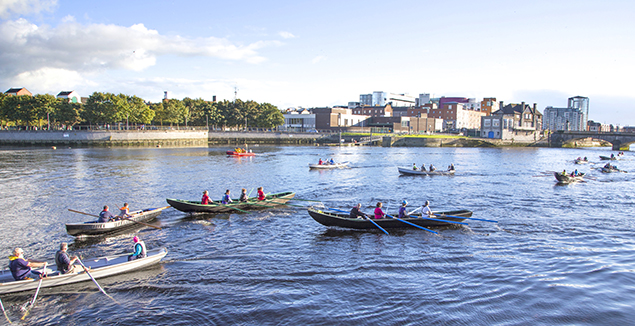 In the end it was Michael Grimes’ currach from Coonagh which won, and the fleet included a good selection of classic black currach types, with four of them here together with three grey Shannon gandelows. Photo: Gary MacMahon
In the end it was Michael Grimes’ currach from Coonagh which won, and the fleet included a good selection of classic black currach types, with four of them here together with three grey Shannon gandelows. Photo: Gary MacMahon
Death of Rower Ailish Sheehan
#Rowing: Ailish Sheehan, the Limerick rower who was badly injured in a fall on Sunday after the World University Rowing Championships in Poznan, has died. BUCS, the British university and colleges sports organization, said in a statement:
British Universities & Colleges Sport (BUCS) is deeply saddened to report the death of Ailish Sheehan on 9th September 2016.
Ailish, a postgraduate student at Goldsmiths, University of London representing the University of London Boat Club, was involved in an accident after the culmination of the 2016 FISU World University Championships for Rowing in Poznan, Poland on Sunday evening, 4th September. Ailish had been competing in the Women’s Four (W4) at the Championships, where she won a bronze medal.
BUCS, British Rowing and Rowing Ireland are providing support to her family during this difficult time and ask for their privacy to be respected.
On behalf of everyone at BUCS, I wish to extend our condolences to the family and friends of Ailish and our thoughts are with them at this difficult time.
Limerick Rower Sheehan in Critical Condition After Fall
#Rowing: Limerick rower Ailish Sheehan (23) is in critical condition after a fall after she had competed at the World University Rowing Championships in Poznan, Poland.
Sheehan apparently fell on a footpath when celebrating taking a bronze medal while competing with the Britain team. With crewmates Rebecca Edwards, Annie Withers and Gillian Cooper, she finished third in the women’s four.
Sheehan, from St Michael’s rowing club, had rowed in an Ireland four at the World Under-23 Rowing Championships in 2013 with Lisa Dilleen, Emily Tormey and Aifric Keogh. They finished fourth.
She had won a scholarship to Notre Dame in the United States in 2011 and completed a degree there in design. She stroked the Notre Dame crew to sixth in the Head of the Charles in 2014. She returned and moved to Britain and switched to the British system.
Bronze for Ireland at World University Rowing
#Rowing: Monika Dukarska took a bronze medal for Ireland at the World University Rowing Championships in Poland today. The Ireland single sculler took a third place behind Germany’s Julia Leiding and Lisa Farthofer of Austria, who just beat her in the battle for silver. The Killorglin woman had been in the Ireland high performance programme until earlier this year.
World University Rowing Championships, Poznan, Poland (Selected Results; Irish interest)
Men
Double - B Final: 3 Ireland (P Doyle, T Oliver) 6:42.56.
Lightweight Single - B Final: 6 Ireland (C Beck) 7:36.15.
Women
Four - B Final: 2 Ireland (A Feeley, A Crowley, S Bennett, E Lambe) 7:14.68.
Double Sculls - B Final: 3 Ireland (O Bouanane, O Blundell) 7:44.83.
Lightweight Double Sculls: 3 Ireland (D Synott, J McCarthy) 6:49.87.
Single Sculls - A Final: 1 Germany (J Leiding) 7:33.73, 2 Austria (L Farthofer) 7:35.35, 3 Ireland (M Dukarska) 7:35.99.
Dukarska Makes A Final of World University Rowing
#Rowing: Monika Dukarska qualified for the A Final of the women’s single sculls at the World University Rowing Championships in Poznan, Poland. The Killorglin woman finished a clear second in her repechage, with two going through to the A Final. There were B Final places for five other Irish crews: the men’s double sculls and lightweight double sculls and lightweight single sculler Chris Beck and for the women’s four and women’s double. Andrew Goff was set for the C Final in the men’s single.
#Rowing: Thousands turned out tonight for the official return of Olympic silver medalists Paul and Gary O'Donovan to Skibbereen, West Cork
The duo and members of team and management travelled in an open-topped bus through the town.


























